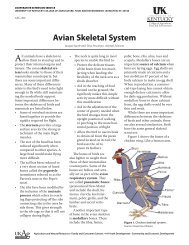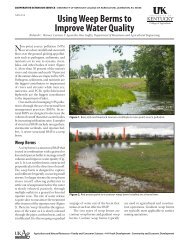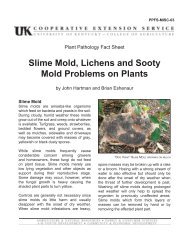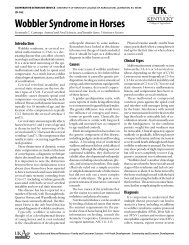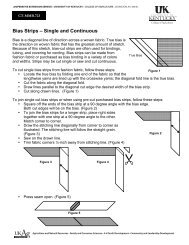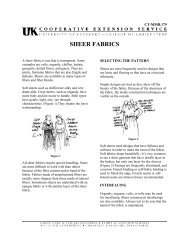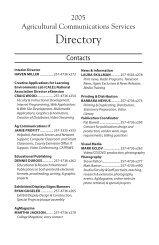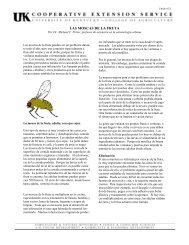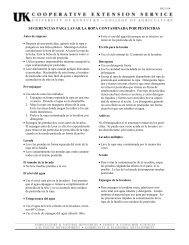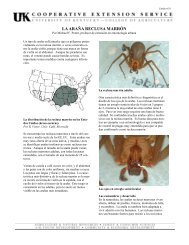Chapter 3 - CHICKEN ANATOMY AND PHYSIOLOGY
Chapter 3 - CHICKEN ANATOMY AND PHYSIOLOGY
Chapter 3 - CHICKEN ANATOMY AND PHYSIOLOGY
You also want an ePaper? Increase the reach of your titles
YUMPU automatically turns print PDFs into web optimized ePapers that Google loves.
The straight and narrow ureter is a tube that leaves the medial border of each kidney<br />
and opens into the cloaca adjacent to the deferent duct of the male or the oviduct of the<br />
female.<br />
The primary component of poultry waste is uric acid, the major end product of protein<br />
utilization. Uric acid is a white, pasty substance. Poultry waste is comprised of urine and<br />
feces (see Figure 3.4); these are not separate.<br />
As indicated in the discussion on the Circulatory system, birds have retained the more<br />
‘primitive’ renal portal system, a feature not found in mammals. The renal portal system<br />
allows blood from the back portion of the body to flow to the kidneys via the iliac veins.<br />
There is a valve that allows blood to either pass on to the kidneys where nitrogenous<br />
wastes are removed, or return directly to the heart via the renal veins. Because of this<br />
renal portal system, drugs injected into the leg muscles may be toxic to the<br />
kidneys; usually it is better to inject into the large muscles of the chest.<br />
Gout is a metabolic disorder associated with the kidneys. In gout the kidney function is<br />
slowed down to a point were uric acid accumulates in blood and body fluids. It can also<br />
leads to accumulation of white uric acid crystals in soft tissues of various organs. There<br />
are two types of gout – visceral and articular.<br />
Visceral gout is a condition in which uric acid crystals are seen in soft tissues. The<br />
visceral form of gout is commonly found in broilers resulting in economic losses due to<br />
mortality and morbidity. The kidney damage can arise from infection with certain strains<br />
of Infectious Bronchitis, Avian Nephritis virus, exposure to some mycotoxins, or<br />
inadequate water intake. Residual toxic effects due to some of the disinfectants have<br />
also been reported.<br />
Articular gout is a condition in which urate crystal deposits are seen in joints. This<br />
condition is rarely seen in broilers. Main causes are genetics and high protein diets.<br />
J. Immune system<br />
The avian immune system operates on the same general principles as the mammalian<br />
immune system. It is divided into two mechanisms – non-specific and specific.<br />
Non-specific immune mechanism includes the inherent ways in which the chicken<br />
resists disease. This protective system is often not considered when designing a poultry<br />
health program. The non-specific mechanisms include:<br />
3.22<br />
• Genetic factors – Chicken strains have been developed which do not have the<br />
required receptors to allow many disease organisms to infect them. For example,<br />
some strains of chickens are genetically resistant to the lymphoid leukosis virus.<br />
• Body temperature – The high body temperature of the chicken precludes many<br />
diseases. For example, blackleg disease and anthrax of cattle are not problems in<br />
poultry. If the body temperature of the chicken is lowered, however, the disease<br />
may occur.



